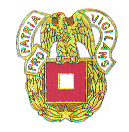Signal Corps (United States Army)
| United States Army Signal Corps | |
|---|---|

Coat of Arms
|
|
| Active | 3 March 1863 – present |
| Country |
|
| Allegiance | United States of America |
| Branch |
U.S. National Guard U.S. Army Reserve |
| Garrison/HQ | Fort Gordon, Georgia, U.S. |
| Motto(s) | "PRO PATRIA VIGILANS" (English: Watchful for the Country) |
| Corps Colors | Orange and White |
| Anniversaries | 21 June 1860 |
| Engagements |
American Civil War Indian Wars Spanish–American War Philippine–American War World War I{Occupation} World War II Korean War Vietnam War Operation Desert Storm Operation Enduring Freedom Operation Iraqi Freedom |
| Commanders | |
| Chief of Signal | COL Robert L. Edmonson |
| Sergeant Major of the Regiment | CSM Robert A. Daniel Jr. |
| Regimental Chief Warrant Officer | CW5 Deshawn Bell |
| Notable commanders |
BG Albert J. Myer BG Adolphus Greely |
| Insignia | |
| Branch Insignia |  |
| Regimental Insignia |  |
The United States Army Signal Corps (USASC) develops, tests, provides, and manages communications and information systems support for the command and control of combined arms forces. It was established in 1860, the brainchild of United States Army Major Albert J. Myer, and has had an important role from the American Civil War through to the current day. Over its history, it had the initial responsibility for a number of functions and new technologies that are currently managed by other organizations, including military intelligence, weather forecasting, and aviation.
Support for the command and control of combined arms forces. Signal support includes Network Operations (information assurance, information dissemination management, and network management) and management of the electromagnetic spectrum. Signal support encompasses all aspects of designing, installing, data communications networks that employ single and multi-channel satellite, tropospheric scatter, terrestrial microwave, switching, messaging, video-teleconferencing, visual information, and other related systems. They integrate tactical, strategic and sustaining base communications, information processing and management systems into a seamless global information network that supports knowledge dominance for Army, joint and coalition operations.
While serving as a medical officer in Texas in 1856, Albert James Myer proposed that the Army use his visual communications system, called aerial telegraphy (or "wig-wag"). When the Army adopted his system on 21 June 1860, the Signal Corps was born with Myer as the first and only Signal Officer.
Major Myer first used his visual signaling system on active service in New Mexico during the early 1860s Navajo expedition. Using flags for daytime signaling and a torch at night, wigwag was tested in Civil War combat in June 1861 to direct the fire of a harbor battery at Fort Wool against the Confederate positions opposite Fort Monroe. For nearly three years, Myer was forced to rely on detailed personnel, although he envisioned a separate, trained professional military signal service.
...
Wikipedia
